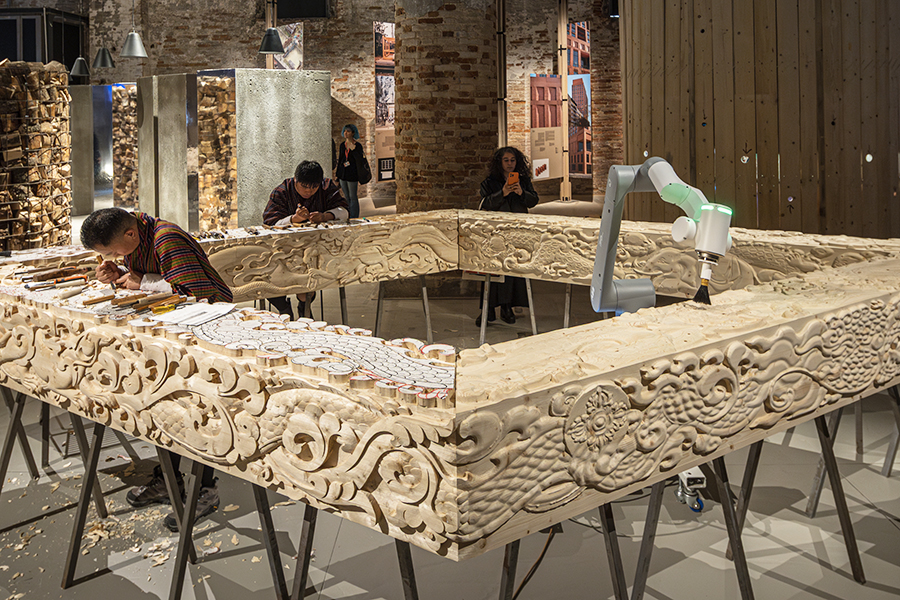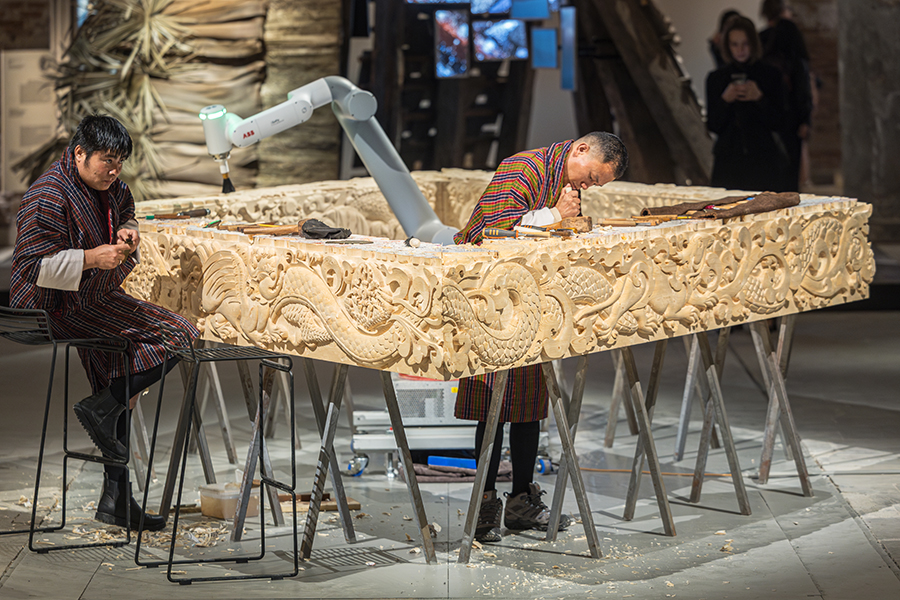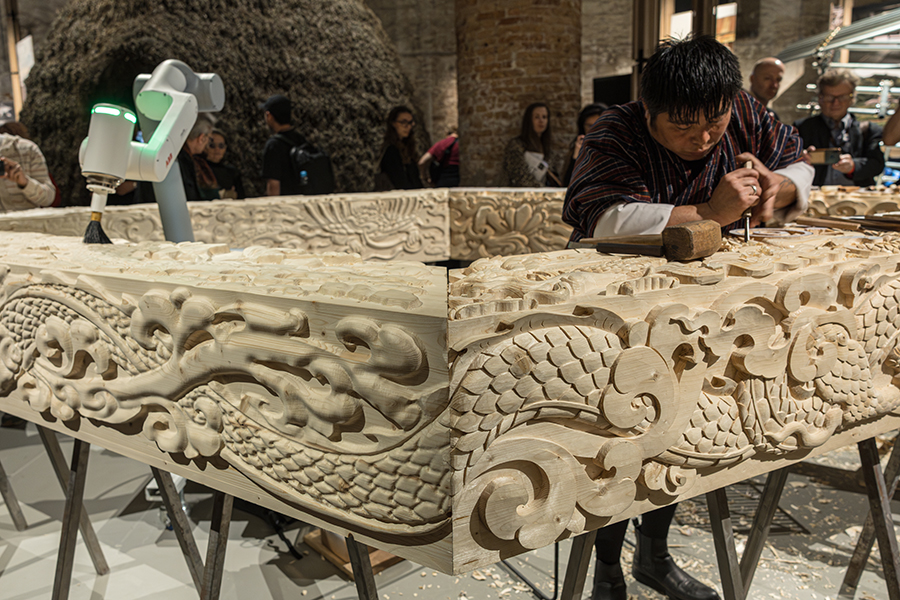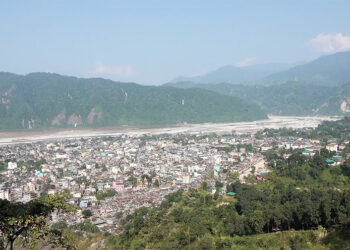 Bhutan has made its debut at the 2025 Venice Architecture Biennale with the design of the upcoming Gelephu International Airport. The project was created by BIG–Bjarke Ingels Group in collaboration with Bhutanese artisans. Titled Ancient Future, the exhibition features live woodcarving alongside robotic tools, showcasing how tradition and technology can coexist. This marks the first time traditional Bhutanese craftsmanship has been featured at this renowned global event, a powerful reminder that honouring the past can guide the path forward.
Bhutan has made its debut at the 2025 Venice Architecture Biennale with the design of the upcoming Gelephu International Airport. The project was created by BIG–Bjarke Ingels Group in collaboration with Bhutanese artisans. Titled Ancient Future, the exhibition features live woodcarving alongside robotic tools, showcasing how tradition and technology can coexist. This marks the first time traditional Bhutanese craftsmanship has been featured at this renowned global event, a powerful reminder that honouring the past can guide the path forward.
At the world’s most prestigious architecture exhibition, a quiet rhythm echoes from Bhutan, not just in sound, but in spirit.
 The live demonstration is the centrepiece of the 2025 Venice Architecture Biennale exhibition. Concept art by Bhutanese artist Tshewang Tenzin and Ugyen Doya, the beams are hand-carved by artisans Sangay Tshering and Yeshi Gyeltshen on one side, and the other side is carved by a machine, following the same traditional designs.
The live demonstration is the centrepiece of the 2025 Venice Architecture Biennale exhibition. Concept art by Bhutanese artist Tshewang Tenzin and Ugyen Doya, the beams are hand-carved by artisans Sangay Tshering and Yeshi Gyeltshen on one side, and the other side is carved by a machine, following the same traditional designs.
“In front, there is an ancient future where you see a collaboration between a robotic arm and two Bhutanese wood carvers. They are creating a structural member of what will be the Gelephu International Airport. What we’ve tried to do is imagine a future that is rooted in the ancient heritage and rich culture of Bhutan,” said Bjarke Ingels, Founder and Creative Director of BIG, Master Planner for Gelephu Mindfulness City.
“I want to tell the youth of Bhutan that our culture and tradition are our strength. So the more we focus on taking care of that, the more resilient our country and our people will become,” said Yeshi Gyeltshen, Artisan.
A documentary playing in the background helps portray Bhutan as a place where ancient traditions and contemporary technologies can harmonise. Through scenes of Bhutanese music, dance, and craftsmanship woven with robotic movements, the film shows Bhutan as a nation navigating the line between heritage and progress.
“One of the main challenges we’ve been facing with the project is that part of the team has never visited the country, and what we have received to construct this part of the exhibition are 2D drawings done by some painters in Bhutan. And one of our goals was to try to convert this drawing into something as realistic as possible,” said Filippo Cartapani, Architect, BIG.
 The exhibit features three unique dragon carvings, each symbolising a different time frame in Bhutan’s journey. The past dragon clutches jewels, the present holds a Dharma Wheel, and the future bears the Double Vajra—emblems of beauty, spiritual awakening, and visionary resilience.
The exhibit features three unique dragon carvings, each symbolising a different time frame in Bhutan’s journey. The past dragon clutches jewels, the present holds a Dharma Wheel, and the future bears the Double Vajra—emblems of beauty, spiritual awakening, and visionary resilience.
“Bhutanese artisans, especially our traditional wood carvers, to feature here is a huge achievement and a proud moment for our country and the Gelephu Mindfulness City project. It celebrates not only the extraordinary craftsmanship of our artisans, but will also inspire a new generation of Bhutanese creatives to take their work to the world,” said Tshoki Choden, Ambassador, Royal Bhutanese Embassy Belgium
“I hope that we will be able to translate that culture and the tools to the machine to be able to help guide the Bhutanese to keep their traditions alive, their craft, but also scale it up to build a city that is really allowing all the crafts to stay alive for the future,” said Giulia Frittoli, Partner at BIG, Partner in Charge of the GMC Project.
“The Gelephu International Airport is very special in the sense that it will not only promote technology, but also art, architecture, and craft, which is a manifestation of Bhutanese culture. Today, we speak of the Gelephu International Airport, and it is coming to reality,” said Tashi Penjor, Director, Department of Human Settlement, MoIT (Lead City Development, GMC).
The exhibition runs until November 23, 2025. After the Biennale, the carved beams will be transported to Bhutan to mark the start of construction on the Gelephu International Airport—envisioned as both a global gateway and the symbolic heart of the Gelephu Mindfulness City.
Karma Samten Wangda







